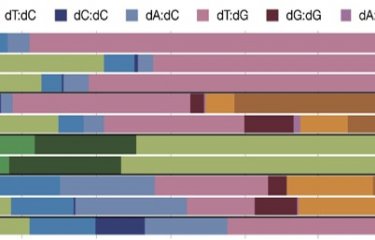Scientists have combined enzyme and chemical techniques to develop an innovative method for producing synthetic DNA molecules. This novel approach opens up many new possibilities, especially for the production of large molecules that can be used for future therapies.
The DNA contained in our cells is the molecule that carries genetic information and serves as the main basis for heredity. It is composed of nucleotides, which in turn are composed of four nucleobases, the building blocks of DNA: adenine (A), cytosine (C), guanine (G) and thymine (T). The human genome contains around 3 billion of these letters, forming a sort of book containing the essential information for our body to function.
As well as its central role in the development and functioning of living beings, DNA is used in a wide variety of different contexts. Its remarkable stability, for example, is enabling scientists to piece together the evolutionary history of the human species. This same stability also means that DNA has the potential to be used as a medium for long-term digital data storage, with its four nucleobases (A, T, C and G) replacing the binary code currently used. In an entirely different field, several projects are under way to develop diagnostic tools based on short sequences of synthetic DNA that can help detect various diseases, such as malaria.
DNA, mRNA and miRNA: therapies sparking growing interest, but with limits
In recent years, several therapeutic applications based on nucleic acids – DNA, messenger RNA (mRNA) and microRNA (miRNA) – have also begun to emerge. The best known example of these is the mRNA vaccine for SARS-CoV-2, which was used at massive scale during the COVID-19 pandemic. But while some drugs are beginning to emerge, the production of these therapeutic molecules remains a tricky process. The chemical modifications needed for the molecules to function correctly in the body mean that they are more complicated to synthesize. For example, therapeutic DNA exceeding 100 nucleotides is extremely difficult to produce using current methods, and this limits drug possibilities.
The discovery of microRNAs awarded the 2024 Nobel PrizeOn October 7, 2024, Victor Ambros and Gary Ruvkun were awarded the Nobel Prize in Physiology or Medicine for their "discovery of microRNA and its role in post-transcriptional gene regulation." miRNAs are RNA sequences composed of around 20 nucleotides that regulate the expression of roughly half the genes in the human body. Although clinical trials have thus far been unsuccessful, these short fragments of RNA open up promising therapeutic avenues, especially for the treatment of some cancers and cardiovascular and neurodegenerative diseases. "In recent years, major progress has been made in packaging and modifying RNA molecules, enabling them to be used in smaller doses and in a more targeted way," explains Marcel Hollenstein. In the medium term, these advances could lead to the first miRNA drugs. |
Longer modified DNA sequences for novel therapeutic possibilities
To overcome these limitations, scientists from the Institut Pasteur, Université Paris Cité, the CNRS and the pharmaceutical firm Roche have successfully developed an innovative method combining chemical and enzyme techniques.
"This is a novel approach that reduces the current limits in the production of modified therapeutic DNA. We use enzymes known as ligases rather than just chemical approaches, and we show that this approach is compatible not only with short sequences of around 20 nucleotides, but also with longer sequences of up to 120 nucleotides," explains Marcel Hollenstein, Head of the Bioorganic Chemistry of Nucleic Acids Unit at the Institut Pasteur. To return to the analogy of the genome as a book, this novel method makes it possible to produce sentences (sequences composed of 120 nucleotides), where previously it was only possible to produce words (sequences composed of a few dozen nucleotides), for therapeutic purposes.
This new method raises prospects both in the field of therapeutic nucleic acids and also more widely for biotechnology applications that require the production of long modified DNA sequences.
Template-dependent DNA ligation for the synthesis of modified oligonucleotides, Nature communications, September 13, 2024
Nazarii Sabat1, Andreas Stämpfli2, Steven Hanlon3, Serena Bisagni3, Filippo Sladojevich2, Kurt Püntener3 & Marcel Hollenstein1
1Institut Pasteur, Université Paris Cité, CNRS UMR3523, Department of Structural Biology and Chemistry, Laboratory for Bioorganic Chemistry of Nucleic Acids, 28, rue du Docteur Roux, 75724 Paris, Cedex 15, France.
2Pharma Research and Early Development, Roche Innovation Center Basel, F. Hoffmann-La Roche Ltd, Grenzacherstrasse 124, Basel, Switzerland.
3Pharmaceutical Division, Synthetic Molecules Technical Development, F. Hoffmann-La Roche Ltd, Grenzacherstrasse 124, Basel, Switzerland





